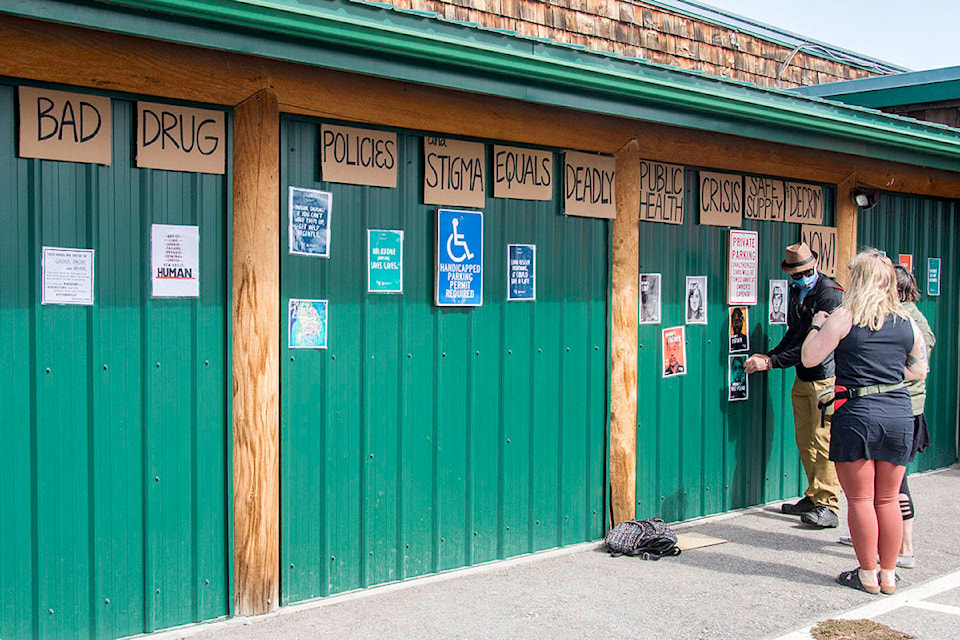Local advocates marked International Overdose Awareness Day in Cranbrook on Aug. 31 by hosting activities, memorializing those who died over the past year, and raising awareness on stigmas surrounding substance use and the drug poisoning crisis
Organized by the East Kootenay Network of People Who Use Drugs (EKNPUD) in partnership with ANKORS, the event was held at the parking lot of the Community Connections Society of Southeast B.C. and included naloxone training, drug-checking information and services, art exhibits, and more.
“Today is about healing because it’s been a really tough year for the overdose crisis,” said Jessica Lamb, a co-founder of EKNPUD. “It’s been five years since the public health emergency was declared in 2016. We’ve lost over 7,000 people — last year was really bad and we’re just on the same rate this year to outdo the numbers from last year.
“It’s about raising awareness in our community because I believe a lot of people just don’t think that this is in our backyard. It’s here and we’ve lost a lot of people this year and it’s about remembering them.”
The day also coincided with the B.C. Coroners Service releasing the latest update on deaths attributed to illicit toxicity substances. In the first half of 2021, there have been 1,011 overdose deaths, according to the update — a 34 per cent increase from the first six months of 2020.
It’s an alarming trend, as last year had the highest number of overdose deaths on record at 1,733.
“The deaths of more than 1,000 British Columbians in the first six months of 2021 is a tragic reminder that the toxic illicit drug supply remains a significant ongoing threat to public health and safety in communities throughout our province,” said Lisa Lapointe, chief coroner, BC Coroners Service, in a news release.
“The data released today [Aug. 31] highlights the immensity of this public health emergency and the need for a wide-scale response. This includes removing barriers to safe supply, ensuring timely access to evidence-based affordable treatment and providing those experiencing problematic substance use with compassionate and viable options to reduce risks and save lives.”
In smaller, rural communities such as Cranbrook, data for overdose deaths is released on a quarterly basis.
According to the latest information from the B.C. Coroners Service, there has been four overdose deaths in Cranbrook this year, and nine in the East Kootenay region. However, what the data doesn’t reflect is the number of overdose-related paramedic calls or situations where a person overdosed, but rescued through intervention by peers or health professionals.
The overdose emergency may be seen as more visible in larger cities such as Vancouver, which has reported 239 deaths in 20201, however, the crisis is also reflected in smaller communities and rural areas across the province.
“I think the problem is public perception right now,” said Lamb. “We’re so divided in this community about homelessness and substance use and mental health…at the end of the day, it’s people’s lives were talking about — Substance Use Disorder doesn’t discriminate.”
Provincially, the huge increase in overdose deaths over the last five years is largely attributed to highly toxic concentrations of fentanyl and carfentanil that is increasingly detected in substances. For example, fentanyl was detected in 86 per cent of overdose deaths in 2020, based on toxicology reports from the B.C. Coroners Service.
In Cranbrook, drug checking services are offered at ANKORS, along with a slate of additional harm-reduction services and tools that can literally save lives.
“We saw that the other day, where it was bought as MDMA, but there was no MDMA, it was straight fentanyl, so for an opioid-naive person, that would’ve killed them,” said Lamb. “So thankfully that was a preventable death because of the harm-reduction tools we have here at ANKORS.”
Sheila Malcolmson, the Minister of Mental Health and Addictions, issued a statement touting the government’s efforts to respond to the crisis, ranging from policy topics ranging from enhancing treatment and recovery, improving substance use system of care, preventing drug poisonings, stepping up community outreach initiatives and finding Indigenous-led solutions.
“We are working hard to separate people from the poisoned drug supply and build more treatment beds and recovery options,” said Malcolmson, in a statement. “Our government has been creating new drug policy in Canada that will save lives by supporting access to prescribed safer supply and connecting people to health-care services, and by moving forward on decriminalization of people who use drugs. We will do everything we can to turn this drug poisoning crisis around.”
